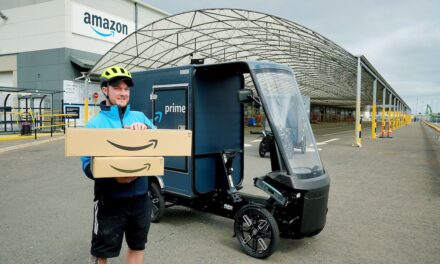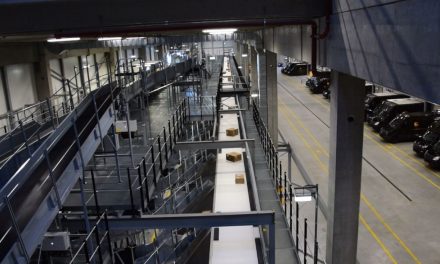
Bring it on home to me
Two-man home deliveries are on the increase as home shopping flourishes and products get more unwieldy. But it takes a special range of skills to get it right, as Marcia MacLeod finds out
If you think the last mile presents problems in the average home delivery operation, how would you deal with the last inch? Two-man deliveries – the ones that handle white goods, furniture, wide-screen televisions, even entire kitchens – don’t involve taking the goods just to the door, but also inside, upstairs, round the corner or out the back. And, as we’re talking about bigger, generally more expensive items, the consumer rightly expects a better service.
The nature of the business also means that delivery companies and retailer hold less, if any, stock. Most orders come direct from manufacturer, many being made to order. It also means that providing an effective home delivery service costs more, and not just to accommodate an extra salary. Better staff, different vehicles, extra staff training and more complex IT systems all require greater financial investment.
Two-man operations remain a small percentage of the home delivery market – some say just 2 per cent, other 5 to 10 per cent – but it is growing at an impressive rate. Exel, which carries out two-man deliveries for Argos, Next, Homebase and Office World, reckons its home delivery business is growing at 10 per cent per annum, and will reach 3.5 million deliveries this year.
Two-man specialist Lane Group claims business is up 20 per cent, while Cranleigh Freight Services’ DHD (Direct Home Delivery) recently doubled its Guildford distribution centre to 90,000 sq ft. Further expansion at its Perth and Manchester distribution centres and/or regional support sites, is also planned.
Fiege Merlin Distribution, another two-man specialist, boasts its white goods business has grown 30 per cent per annum over the last two years, partly because furniture, white goods and so on are getting bigger, making it harder for consumers to arrange their own delivery. Growth of catalogue and internet sales of furniture and white goods is also stimulating the market.
Steve Barter, strategic development director at Fiege Merlin, thinks the market will stabilise. "We won't see the same levels of growth," he predicts, "but the type of services and the value-adds being offered will continue to grow."
Fiege Merlin has now launched a "Platinum" service dedicated to high-value bulky items, such as American side-by-side fridge/freezers and big range cookers. "These are extremely awkward to handle, require extra staff training and generate less productivity," says Barter. "We can’t deliver as many in a day, so the service costs more. But people are prepared to pay a bit more if they get a better service – and the delivery cost works out at a lower percentage of the purchase price."
Francois Lacombe, corporate business development director at ACR Logistics (formerly Hays), agrees two-man operation is a growing business, but believes "there will be a concentration of the business." The concentration has already started: Endeva for one has pulled out of the market. But those who are left point to a significant opportunity, if the operator can get it right.
Dealing with the consumer is, as with any home delivery, the hardest part of two-man operations; it is even more important than with other home deliveries to ensure someone will be home to receive the item. You can’t drop a three-piece suite at the neighbours!
"The carrier must have a method to make an arrangement with the home owner to ensure someone will be there to take delivery," emphasises Tony Pattemore, managing director of Nightfreight. "And, even more important, the carrier must ensure it meets that arrangement."
Nightfreight offers two two-man delivery services – Pacemaker, split 50/50 between vending machine installation and furniture, and Deliver2Home, which deals with fitness equipment, DIY products and similar items – goods that are too much for one driver to cope with, but aren’t "big ticket" items. Once Nightfreight "catches sight" of the product and plans the vehicle’s activity, its call centre staff member rings the consumer and makes a delivery booking. Two deliveries are made per week to most areas of the country.
"To keep costs down, we have to make vehicles efficient and try to get people to fit in with our schedule," says Pattemore. "If an item is very expensive, however, the consumer’s expectation is different. If they’ve spent £3,000 for a three piece suite, it’s their pride and joy; they expect a better service. So we try to work round the customer."
Most two-man operators either book the delivery direct with the consumer, and/or call ahead to ensure the consumer is aware of the pending delivery. Drivers then call again on the day of delivery, often 30 to 60 minutes in advance of estimated time of arrival (ETA). Mike Dennison, operations director for Caretakers, speaks for many when he says "we don't deliver anything without contacting the customer and making sure they will be in."
TNT Logistics uses call centres run by itself and by Habitat, and supports in-store, call-centre and online sales. Hammond operates two systems for one customer: it either takes delivery bookings in-store for things bought on site, using a delivery service kiosk, or, for things not available in-store (or at least not in the store in which the customer is shopping), it books delivery from a central distribution system.
Morning, afternoon, or all-day delivery times are common, but some companies give a shorter hour time window, if the retailer and/or consumer is prepared to pay for it. Others offer night-time and/or weekend deliveries. Hammond Logistics will deliver orders up to 10.00pm; Cranleigh drops on Saturday; ACR delivers seven days per week from 7.30 to 21.00 for Marks & Spencer.
Communication is important. "Giving customers plenty of advance warning is the key," says Jonathan Chadburn, Exel’s divisional director. "Customers want their delivery and will usually be flexible to help get it. But if any delays occur, we can’t wait until 15 minutes before ETA to tell the waiting consumer."
ACR Logistics uses its own booking centre, operating seven days a week, to set up delivery seven days in advance. Drivers then call an hour before ETA, although SMS messaging is used in some cases. TNT Logistics, which handles deliveries for Habitat, only accepts bookings on time slots it can guarantee to serve, taking into account production lead time for any made-to-order item. It is currently piloting the use of routing and scheduling software to stimulate a route in advance, allowing time slots to be optimised at the time of booking.
Fiege Merlin also calls at least a week before delivery and again on the evening before, with the driver backing this up with a call on the morning of delivery to tell the consumer where he/she lies in the day’s schedule. "We can’t always be as flexible as consumers would like," admits CEO Paul Clarke, "as routes must be run efficiently. But our call centre is proactive using pre-programmed automatic call-aheads with recorded messages telling consumers when to expect their orders. We are also trialling text messaging, which would provide a constant reminder of the forthcoming delivery."
Communications with consumers isn’t just about ensuring someone is at home, though. Cranleigh and Lane Group both emphasise the need to ascertain any access problems in advance. "We call consumers at least 48 hours in advance to agree a mutually convenient delivery time," explains David Kennard, commercial director. "But we also find out about access. We ask ‘Does the dustcart come to your door?’, because if it doesn’t, our 7.5-tonne box van won’t make it either, and we switch to a smaller vehicle. If we leave a message but don’t receive a reply, we don't deliver."
Hammond Logistics also asks customers to confirm there are no access restrictions by giving them a copy of its terms and conditions. "If the crew arrive at an address and think they can’t access the house or deliver the goods (through a doorway, for instance) without damaging the consumer’s property or that of the neighbours, the crew will tell the customer: ‘We don't think we can deliver this without causing damage. Are you prepared to take responsibility?’ If the consumer won’t sign a waiver, the goods go back."
Lane Group goes even further. It, too, phones in advance, although texting is coming in later this year. But it also sends a photo of the vehicle it plans to use, asking consumers to confirm it can get down the street. It also makes sure there is sufficient room in the house to bring the goods in, unpack them and so on.
Drivers bar-code items in the consumer’s home, using an XDA (an advanced PDA, which includes phone, camera and scanner). Drivers take pictures of any damage outside or inside the home – gatepost, front door, other furniture – before beginning delivery. If the consumer tries to claim the driver caused the damage, the company has timed proof to the contrary.
The XDA is also used to scan all delivered items, identifying any missing parts to the order. If, for example, one item of an entire kitchen delivery has been mis-packed, the driver can trace it to other deliveries and extract the item from the vehicle before leaving the address, since most mis-packed items are elsewhere on the same vehicle.
In addition to phones and text messages, some companies, such as Cranleigh, now have a web-based track and trace system allowing home owners to check the status of their own order. All the careful planning pays off: unlike other home delivery services, two-man operations usually experience only 1-2 per cent of "no shows".
But clear and accurate delivery are not sufficient, by themselves, to generate success in two-man operations. The right crew can make or break a company. For a start, crew have to be fit; lifting and manoeuvring an amazing 15 to 30 heavy deliveries a day is demanding work. Health and safety training is essential for all two-man crews. Handling aids can help; Cranleigh uses forearm "forklifts" – nylon straps with looped ends, through which drivers put their arms, to allow weight to be carried on the forearm, rather than the wrist.
Crew also have to be polite, well dressed (uniformed or not) and customer-service oriented. "It is crucially important the driver respects he is delivering into someone’s home, going across carpets or good wooden flooring and so on," emphasises Rebecca Jenkins, managing director of Lane Group. "Drivers have to wear gloves, put down protective floor covering and so on. They have to be knowledgeable about the product, too, to answer consumers’ questions."
Lane trains its staff for one or two days three or four times a year. Videos are used to show standard processes and procedures, such as telling consumers "we will be parked outside for five minutes, completing paperwork, if you have any questions". Further training is given on new products or regulations.
"Staff have to be trained in paperwork and how to behave in the house," agrees Nightfreight’s Tony Pattemore. "They have to look for things that might get damaged, like a wooden floor or paintings on the wall, and to protect or remove them. They also have to be patient and give the consumer time to check the order before signing for it."
ACR even uses a mock house for the drivers’ week-long training session, in which they are again taught what to look for that might be damaged – down to light fittings – what needs to be removed or protected, and so on.
All delivery companies will ensure items are unpacked, with packing removed, and placed in the room of the consumer’s choice. Some will plumb in a washing machine, install an electric cooker, or take an old item away. Others, like Cranleigh, assemble wall units, electric beds, and so on, while Fiege Merlin employs Corgi-registered professionals to install gas appliances.
None of this comes cheap – but, as orders are usually fairly expensive, both retailer and consumer are prepared to pay a little more. Consumers who object to what may be a £40 delivery charge usually change their mind, says Dean Partington, Hammond’s commercial director, when they compare it to the cost of hiring a van and two men themselves, but retailers, too, are looking more favourably at two-man deliveries.
"Cost depends on the size of the product, space in the vehicle, delivery parameters," says Jenkins. "But retailers are waking up to the fact that delivery is an important part of the retail experience. They have to get it right."













